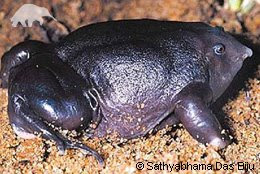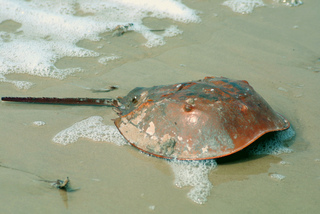As a comment on my Copperbelly Watersnake post, Gargoyle Grins asked—very nicely—for a post on the Purple Burrowing Frog. I’m not sure when the comment was made, but I only saw it recently. I am more than happy to oblige a reader.
Having only been formally described in 2003, there is a surprising amount of information known about the Purple Burrowing Frog (Nasikabatrachus sahyadrensis). So far, it has only been found in two small areas in Western India, where it spends most of its time buried underground.
There are two major reasons for its subterranean lifestyle: it’s moist underground, and that’s where the termites live. With minimal eyes1, the Purple Burrowing Frog relies on smell and touch to hunt. The pointy nose is useful for shoving through termite’s walls, and it has a tongue specially shaped for sucking up the little morsels. The Purple Burrowing Frog depends on termites for more than just a food source. The structures and tunnels built by the termites help aerate and moisten the soil. It is the only burrowing frog that feeds underground; all others simply hide in the dirt to avoid predators.
During the monsoon season, however, the frogs come out to breed. They make their way to nearby water sources, and begin the mating process. Due to similarities to other species, it’s probable that the male temporarily glues himself to the back of the female during amplexus. Since it was only discovered in 2003, there are still quite a few uncertainties about its lifecycle.
Our lavender friends are listed as endangered by the IUCN because the range it has been found in is so small, and the forests under which they dig are threatened by expanding cultivation. Much more needs to be learnt about this animal before conservation efforts can be put into place.
1Eye reduction happens a lot in underground animals.
 |
| Image by S.D. Biju via EDGE |
There are two major reasons for its subterranean lifestyle: it’s moist underground, and that’s where the termites live. With minimal eyes1, the Purple Burrowing Frog relies on smell and touch to hunt. The pointy nose is useful for shoving through termite’s walls, and it has a tongue specially shaped for sucking up the little morsels. The Purple Burrowing Frog depends on termites for more than just a food source. The structures and tunnels built by the termites help aerate and moisten the soil. It is the only burrowing frog that feeds underground; all others simply hide in the dirt to avoid predators.
During the monsoon season, however, the frogs come out to breed. They make their way to nearby water sources, and begin the mating process. Due to similarities to other species, it’s probable that the male temporarily glues himself to the back of the female during amplexus. Since it was only discovered in 2003, there are still quite a few uncertainties about its lifecycle.
Our lavender friends are listed as endangered by the IUCN because the range it has been found in is so small, and the forests under which they dig are threatened by expanding cultivation. Much more needs to be learnt about this animal before conservation efforts can be put into place.
1Eye reduction happens a lot in underground animals.

